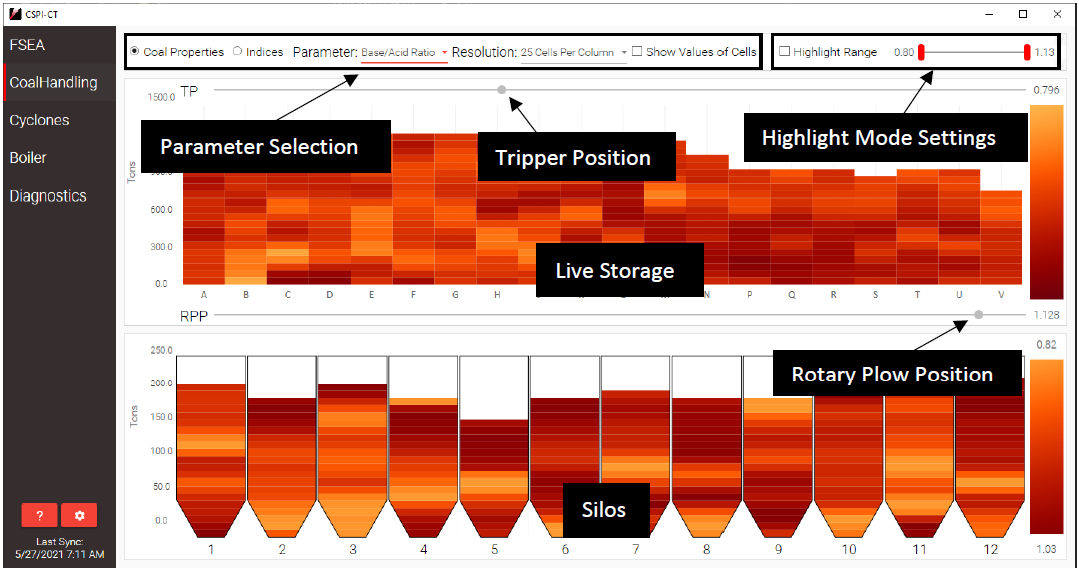Energy System Performance Manager
Introduction
Figure 1. ESPM fuel performance assessment page.
Microbeam Technologies, Inc. (MTI) developed the Energy Systems Performance Manager (ESPM) to monitor, manage, and optimize operations in various types of power plants and fuel handling systems. The ESPM tracks fuel properties and composition information from on-line sensors fuel handling system to the burner. The system is designed to sort and blend fuel based on the plant’s optimum performance parameters and feedstock available. The ESPM also monitors current performance and can be used to forecast performance based on current fuel inventory. Figure 1 shows the diagnostic screen derived from ESPM.
Technology Implementation
ESPM operates on multiple levels of detail, catering to the diverse needs of plant operator and engineering staff. It uses the output from on-line sensors to provide real-time feedstock properties, fuel property information for sorting and blending, and forecast performance based on feedstock blend properties. The tool's versatility allows it to display individual operational parameters to the minute, while also providing high-level plant performance indices calculated from multiple parameters. Additionally, ESPM incorporates advanced predictive analytics (indices), neural network- and linear regression-based algorithms, and condition-based monitoring to anticipate operations and condition changes.
Case Study: Lignite-Fired Power Plant
A mine-mouth power plant rated for 450 megawatts serves as the focal point of this case study. The plant implemented a full-stream elemental analyzer (FSEA) based on prompt gamma neutron activation analysis (PGNAA) in 2018 and two multi-gamma attenuation (MGA) sensors in 2020 to continuously monitor coal quality. ESPM was integrated into the plant's infrastructure in 2019 to monitor coal quality and flow throughout the system, from delivery to combustion. By utilizing data from plant operations and sensor outputs, ESPM facilitates feedstock tracking and blending, and calculating indices that provide information on the impacts of fuel properties on boiler performance.
ESPM establishes and maintains an inventory of coal starting at the FSEA and moving through the entire system, providing operators visualizations of fuel properties at various points. The program was built using only design parameters from the plant and was used to simulate the flow of coal through the live storage system using data from plant operations and results from the FSEA and MGA sensors. The live storage and silo display in ESPM is shown in Figure 2, and sample output from the MGA sensors is shown in Figure 3.
In addition to feedstock tracking, MTI has developed predictive performance indices that help operators guide operators in blending and optimizing available fuel. The predicted indices are used in the Diagnostics module of the program to provide an easy to understand, high-level view of system performance. The health of each individual section is calculated on a scale of 1-100 based on a collection of operational parameters, calculated indices, current and projected feedstock characteristics, and physical and chemical behaviors known to occur at certain stages. A section will be colored green when performing efficiently, yellow when attention is required, and red when performing poorly. The corresponding ESPM section is shown in Figure 1.
Figure 2. ESPM's CoalHandling page. Above: cross section view of live storage. Below: cross section view of silos.
Figure 3. ESPM's MGA sensor page. Above: feedstock properties based on sensor output. Middle: operational parameters provided by the plant. Below: hourly and daily averages for all parameters.
Features and Benefits
Descriptive Analytics – Ability to track feedstock from point of delivery through entire system, enabling sorting and blending to manage feedstock properties
Diagnostic Analytics – Advanced plant performance predictions based on feedstock properties and operating conditions
Predictive Analytics – Neural network based predictive algorithms
Prescriptive Analytics – Recommendations for optimal feedstock properties and operating conditions for improved performance
System Requirements
Access to distributed control system to retrieve operational data associated with relevant parameters to be monitored in real time
Access to sensor data in real time



